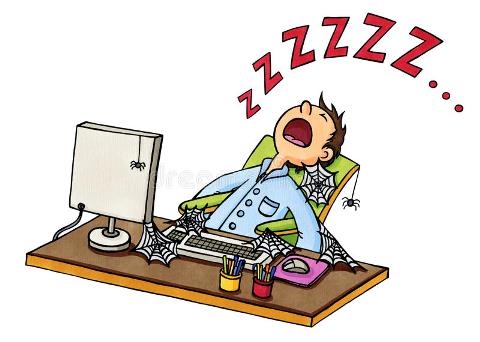 May 2023
May 2023
There have been quite a few articles on-line lately about how to speed up your PC. Some advocate ending certain Windows processes to make your PC run faster. But is that such a good idea?
There is a lot of information available on the Internet. Some of it is valuable and some of it is just plain garbage. These are some of the often-mentioned processes that you can safely shut down to speed things up. Let’s take a closer look at them. What precisely do they do, and can you really speed things up by ending them?

- Ctfmon.exe
- NewsAndInterest.exe
- GrooveMusic.exe
- LockApp.exe
- OneDrive.exe
Ctfmon.exe
What is it? Some people think it is a virus. The Collaborative Translation Framework or the CTF Loader, (they are basically the same thing) is part of Microsoft Windows. It controls the Alternative User Input Processor and the Microsoft Office Language Bar. It can provide text support for handwriting recognition, speech recognition and other alternative user inputs. So, if you are using any of these inputs and you stop ctfmon these inputs will no longer work.
Normally ctfmon runs in the background and does not interfere with the normal operation of the system. Unfortunately, some malware disguises itself as ctfmon so it can avoid detection. The genuine ctfmon resides in the C:\Windows\System32 folder. You can Right Click on the process in Task Manager and click “Open file location”. If it is in the System 32 folder then it is the genuine file, if not then your next step should be to run a virus scan.
NewsAndInterest
When you search in the search bar you get personalized news, weather, information and content based on “your interests’. Actually, it is based on previously visited pages and previous searches. This “invasive advertising” is built into your PC. In Windows. This can use a lot of memory under certain circumstances so in some cases you might get a noticeable improvement in performance.
Some people turn off the news and interest feature just because they find it annoying. You will still get ads in your browser. They just won’t be adjusted to your interests.
Groove Music
In most cases the default music player in Windows 11 is Media Player. Microsoft decided to replace Groove with an updated version of Media Player back in 2021. Windows 10 still uses Groove, at least for now. However, Media Player is in there too. In Windows 11 groove music isn’t even there.
LockApp.exe
LockApp controls the Windows lock screen. It is responsible for overlaying a graphical interface over the locked screen when the computer has been idle for a long time. You see this overlay screen just before you log in. While the computer is in use it doesn’t do anything, in fact it is usually suspended during normal operation.
Like ctfmon, lockapp,exe has been known to get hijacked by malware pretending to be lockapp. You can check it the same way as described for checking ctfmon.exe. It should be in C:\Windows\SystemApps\
If you turn your computer off when you are not using it then the lock screen seldom shows up. If you leave the machine running and just lock it, (Windows Key + L) then you will get the lock screen until a certain amount of time has passed and the computer turns off the screen. You can disable it but in normal operation it doesn’t use a lot of resources, so you won’t see much of an improvement in performance.
OneDrive
Most mobile devices don’t have a lot of storage space. What would easily fit on a desktop machine with a terra byte drive may not fit on your phone tablet, notebook or even some laptops. To get around this problem without resorting to extra external devices they store documents, pictures and other files in the cloud. Windows includes a small amount of cloud storage which can be expanded for using OneDrive. It is also a good way to share files across many devices.

I have had customers who suddenly realized that OneDrive isn’t syncing properly and many of their files were no longer available. This usually happens when you are operating under tight deadlines and can be a real stress generator. Since it doesn’t take a lot of resources and actually frees up storage space disabling it may not speed things up much and could cause other problems.
Disabling the processes
To disable ctfmon go to Task Manager Right Click the process and click End task. The classic way to open Windows Task Manager is to press Ctrl + Alt + Delete all at once and select Task Manager from the menu. Alternatively, you can just Right Click on the Task Bar. In Windows 10 you may need to click the More details link to expand the menu and click on the Processes tab.
Be advised that disabling ctfmon will cause some parts of Windows 10 to stop working. In Windows 11 ctfmon.exe is located under the Details tab and you cannot disable it. If you try to use the end task it will just start up again.
These steps only disable the process until the next restart. You cannot simply uncheck a box in the startup apps list. To permanently disable ctfmon.exe you will have to completely unregister the DLL files that run the alternative input devices. Just for the record, I do not recommend doing this, so I am not going to list the steps to permanently delete ctfmon. If you are really determined to shoot yourself in the foot you will have to Google it up yourself.
To disable NewsAndInterests there are different steps to take depending on which version of Windows you are using. In Windows 10 right click an empty portion of the taskbar select News and Interests and click Turn off.
In Windows 11 there is the widgets bar that opens on hover and the News app. Click on the Widgets icon in the task bar and click Settings in the upper right corner of the Widgets board. Toggle off the Open Widgets on hover switch. You can uninstall the news app much like any other app and reinstall it if needed.
To disable Groove Music in Windows 10. You could disable GrooveMonitor in the Windows 10 startup if you don’t mind reverting back to the old Media Player. It won’t get you much of a performance gain since the app has a low startup impact. You can uninstall Groove Music like most any other app. Go to Settings and Apps and features. Scroll down to Groove Music click on it and click uninstall.
To disable LockApp You won’t gain much increase in performance by disabling LockApp. You can end the task in Task Manager but once the system goes through a restart it will be back. Like ctfmon.exe it may not be listed in the startup programs either so you can’t just uncheck the box to disable it.
To disable OneDrive. There are several ways to disable OneDrive. The easiest way to do that is from within OneDrive. Alternatively, you can disable OneDrive through Group Policy or by editing the registry. If you decide to do this just Google up How to disable OneDrive. There are plenty of sites that will provide the necessary information.
If you really want to speed up your PC there are better ways to do that than taking an axe to the operating system.
Run a full virus scan in both Protected Mode and Safe Mode. You can start with Windows Defender, but you will probably need an additional scan with something like Malwarebytes to scan in Safe Mode. You should restart the computer after scanning.
Check for low disk space. In File Explorer click on This PC and it will show the state of each hard drive in the system with a bar graph and percentage of drive space available. If you have less than ten percent available space you should move some files to another location to free up drive space.

Uninstall any unused programs. Check in Control Panel under Programs and features. Do you have software for an old printer that you no longer have? Or an old camera or other programs that are no longer used? If so, then uninstall them. You should restart the computer after uninstalling the programs.
Make sure you are current on updates. Normally your Windows 10 or 11 PC will automatically install important updates, but it is best to make sure. Click the start button and click Settings, (the Gear icon). Click Windows Update on the left panel. Click the Check for updates button and let it search for any updates. Install any updates that are listed.
Run Disk Cleanup. Type Disk Cleanup in the search box in the taskbar. Select the drive you want to clean up, (if you have more than one drive you should repeat the operation for each drive). Click OK and click the button for Clean up system files and then select all the checkboxes then click OK. This may take a while so go get yourself a snack and watch the paint dry, (so to speak).
Run the System File Checker. From a command prompt type (sfc.exe /scannow) without the parenthesis and press enter. To open a command prompt type cmd in the search window in the task bar and click Run as administrator. This will check the Windows system files for possible corruption or missing files. The system File checker may look like it has stopped. This is not unusual, just let it keep running until it finishes. There are three possible outcomes:
- No problems found.
- Problems found and fixed.
- Problems found but could not be fixed.
Run DISM.exe, especially if the System File Checker found problems that it couldn’t fix. This is a more extensive check of the operating system files. Like sfc.exe DISM must be run from a command prompt. Type in the command prompt, or copy and paste the following, (Dism /Online /Cleanup-image /RestoreHealth) without the parentheses and wait until it finishes. It may look like it is stuck but don’t interfere, just let it run. It should return the result “The operation completed successfully”.
It is a good idea to run sfc.exe again afterwards until it returns the result of No problems found.
If all else fails the last option, (the so-called nuclear option) is to restore your computer. Either to a previous restore point or to original factory condition. If you use a restore point you will lose anything done since that restore point was created. If you use the original factory option, it will remove everything back to original condition when the computer first came out of the box.
If you know someone that you think would enjoy this newsletter, share it with them and ask them to join using the link at the bottom of the page.
And remember — always back it up!